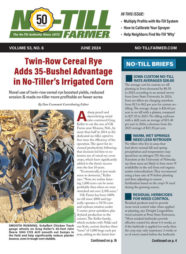With low grain prices and a declining wheat acreage, Guy Swanson believes winter canola could replace a considerable amount of the winter wheat grown in the western U.S. The result could be higher incomes for no-tillers, bonus opportunities for turning out a high-quality product and a dramatic reduction in soil erosion.
The head of Exactrix Systems in Spokane, Wash., Swanson says a properly fertilized winter canola crop should gross around $290 with a cash outlay of only $90-$120 per acre. There’s growing demand for the crop, as U.S. food and fuel processors buy over $700 million of Canadian-grown canola oil, seed and meal each year.
In Canada, canola is grown on 16 million acres, while the U.S. acreage stands at only 1.7 million acres. As canola production continues to increase in the western Canada prairies, so does the percentage of the crop grown with no-till.
Trim Erosion Losses
Swanson says replacing 2 million acres of U.S. winter wheat with no-tilled winter canola could trim soil losses by at least 10 times the amount that occurs with growing winter wheat. As an example, he maintains that winter wheat is responsible for 90% of the soil erosion that takes place in Washington, Oregon and Idaho. This represents 1,500 pounds of lost topsoil for every bushel of exported wheat from the area.
“When properly implemented, no-tilling Roundup Ready winter canola drops soil erosion levels well below the expectations of any other cropping system,” he says. “Winter canola also offers better returns than winter wheat and growers can earn bonuses for higher protein and oil content.”
No-Till vs. Summer Fallow
By the 1970s, numerous oilseed and pulse crops were being seeded in western Canada, of which canola was the most important. The continued adoption of no-till, along with both the agronomic and economic benefits of canola, dramatically changed crop rotation needs and led to the demise of summer fallow. Suddenly, crop rotations on Canada’s western prairie farms included more than just growing wheat after wheat.
No-tilled or strip-tilled in 30-inch rows, winter canola not only offers a good profit margin, but protects the soil over the winter much like a cover crop. Harvest normally takes place 2 weeks ahead of wheat, which spreads out the harvesting season for growers.
“Winter canola helps build soil quality and its early establishment protects soils that tend to erode under winter wheat production,” Swanson says. “Adding winter canola to a no-till rotation is a paying proposition. No-tilled wheat and corn yields often jump as much as 10%, as winter canola helps overcome serious nematode concerns.”
With low wheat prices and returns, it’s time for U.S. wheat growers to take a closer look at the many benefits of no-tilling canola.







Post a comment
Report Abusive Comment